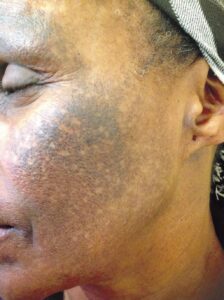Skin bleaching, a practice aimed at lightening the skin’s tone, has been common in many cultures for decades. While some use it to treat medical conditions like hyperpigmentation, a significant number adopt it for cosmetic reasons, driven by societal and cultural pressures to conform to specific beauty standards.
However, the pursuit of lighter skin comes with severe health risks, especially when bleaching products are used improperly or excessively.
The primary ingredients in many skin-bleaching products are hydroquinone, corticosteroids, and mercury.
Each of these substances poses significant health risks when used over prolonged periods.
1. Hydroquinone
Hydroquinone reduces melanin production can cause ochronosis and may increase skin cancer risk with prolonged use.
2. Corticosteroids
Long-term use of corticosteroids in bleaching creams can thin the skin, increase infection risk, delay healing, and cause adrenal suppression, affecting hormone production.

3. Mercury
Despite bans, mercury is still in some skin-bleaching products. Mercury toxicity can damage kidneys, cause neurological issues, cognitive impairment, and potentially fatal poisoning.
Chronic use of skin bleaching products can lead to various health issues:
i) Skin Thinning: Extended corticosteroid use in bleaching creams thins the skin, increasing bruising and tearing risks.
ii) Acne and Dermatitis: Bleaching agents can damage the skin barrier, causing acne and dermatitis.
iii) Infections: Thinned skin is more prone to infections and chronic skin issues.
iv) Kidney Damage: Mercury and other toxic substances can accumulate in the kidneys, leading to renal failure.
The psychological and social impacts of skin bleaching are significant. Many individuals who bleach their skin experience low self-esteem, body dysmorphia, and social anxiety.
Understanding these dangers is crucial for making informed choices about skin care. Prioritizing safer alternatives and fostering a broader acceptance of diverse beauty standards can reduce these risks and promote healthier, more inclusive definitions of beauty.




